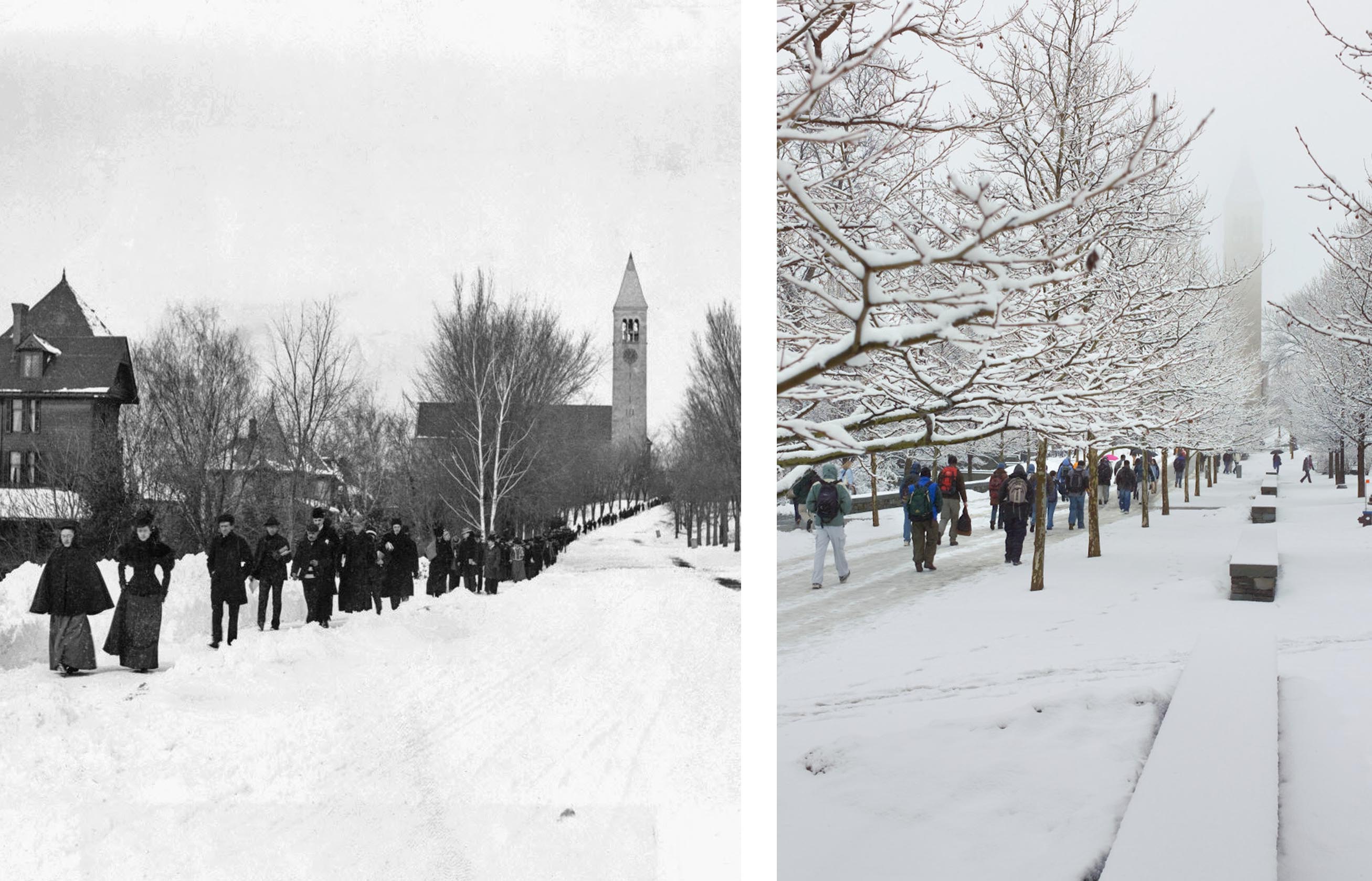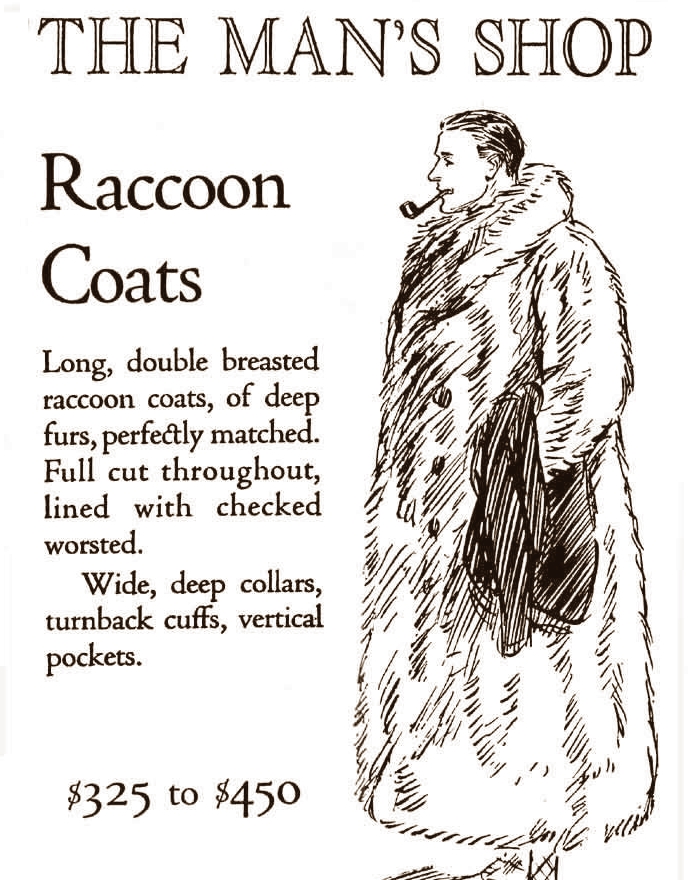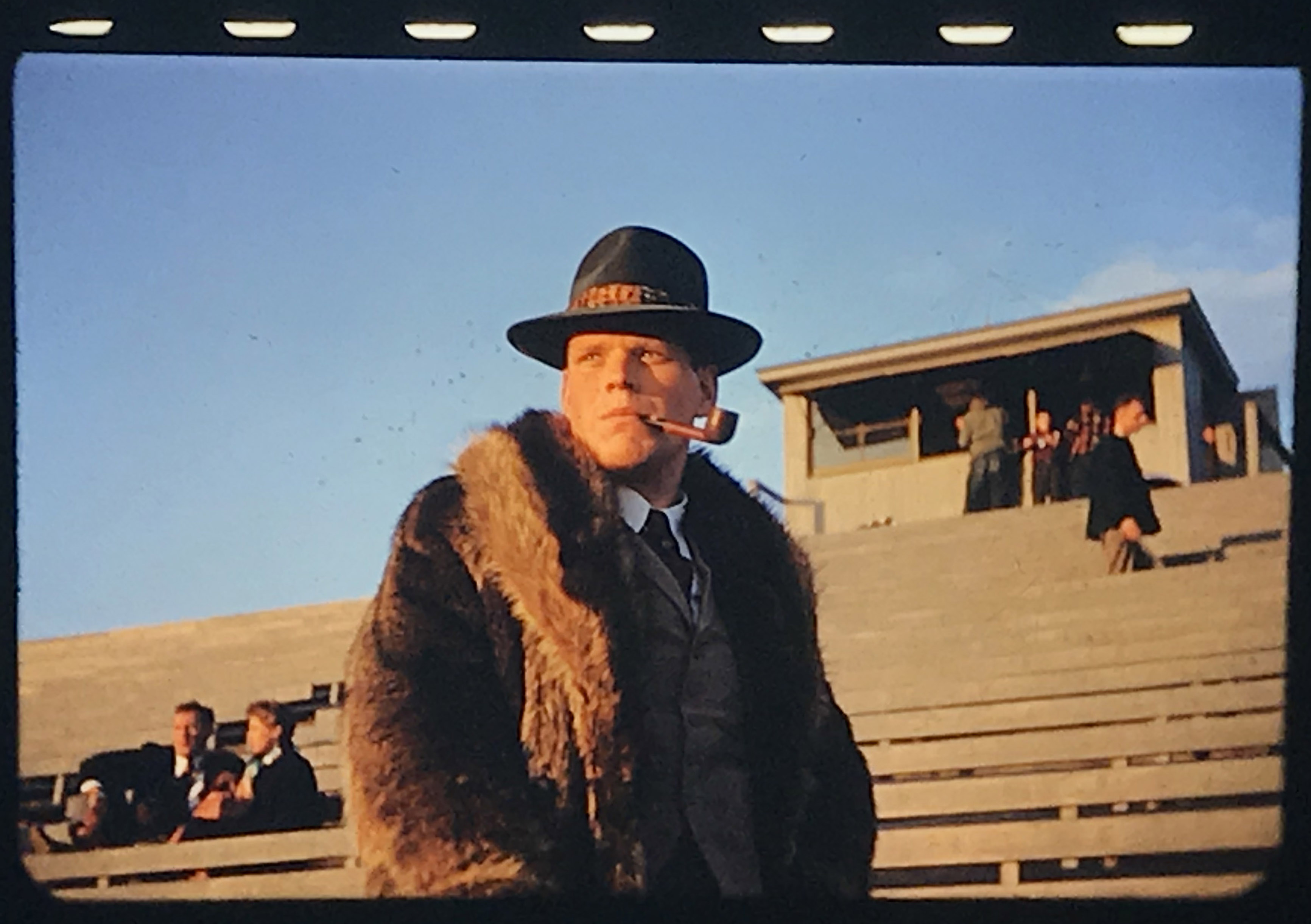Blog post by Amanda Dubin ’18
As all Cornell students and alumni know, surviving a harsh Ithaca winter is challenging. The streets are constantly covered in snow, which soon turns to slush and eventually freezes over into ice. Going to school in Ithaca, NY, it is no surprise that students pile on layers just to keep warm during the cold winter months. Walking down Ho Plaza on a snowy afternoon, for example, you find students bundled up from head to toe in down parkas that shield them from the harsh winds. Hefty coats are combined with thick boots to tromp through heavy snow. Although students wear long winter coats by necessity, what is often overlooked is the power of a winter coat to divide a campus.

Cornell students walking down Ho Plaza in the snow. On the left in 1898 and on the right in 2018 (photo by Nicola Kountoupes)
When I was first accepted into Cornell, I often heard, “a Canada Goose is the unspoken dress code at Cornell.” At the time, I didn’t even know what a “Canada Goose” was; however, four years later I now find the brand everywhere I turn. While warmth and protection may appear to be the primary drivers of this trend, the steep price tag of these down parkas help them take on an entirely different meaning. These jackets are far more expensive than your typical winter coat, with prices ranging from $450 to well above $1,000. Canada Goose jackets are distinguishable from other coats by their small red, white, and blue patch on the upper arm. While the patch is good branding, it is a status symbol more than anything.
Winter coats have long served as status symbols on Ivy League campuses, and the Canada Goose parka is simply the latest iteration. Nearly a century ago raccoon coats were popularized by elite male students in order to combat the cold, but also to convey their social status. While these fur coats definitely helped to keep the wearer warm, they were flashy more than anything. Like the current Canada Goose trend, these raccoon coats served as a symbol of affluence and privilege. Raccoon coats boasted a colossal price tag: according to a 1921 advertisement, they ranged from $325 to $450, which is the equivalent of about $4,000 to $6,000 in today’s U.S. dollar. The roaring 20s were a period of prosperity and overindulgence, which trickled down into Cornell’s youth culture.
The raccoon coat quickly became a symbol that epitomized a privileged collegiate male. Pop culture references of the era include George Olsen and his Music’s 1928 single, “Doin’ the Raccoon.” The following lyrics demonstrate how powerful this trend really was in symbolizing collegiate lifestyle:
College men, knowledge men,
Do a dance called raccoon;
It’s the craze, nowadays,
And it will get you soon.
Buy a coat and try it,
I’ll bet you’ll be a riot,
It’s a wow, learn to do it right now!
[…]
From every college campus comes the cheer: oy-yoy!
The season for the raccoon coat is here, my boy!
Rough guys, tough guys, men of dignity,
Join the raccoon coat fraternity, soon,
To do the raccoon.

Cornell students in the mid-1920s. Photo credit: Cornell University Library Division of Rare and Manuscript Collections.
The raccoon coat craze ended with the Great Depression, but the trend was revived on college campuses after World War II. The Cornell Costume & Textile Collection includes one such raccoon coat, which was purchased by Courtney Crawford when he began his undergraduate at Columbia in 1947. He continued to wear the coat as a law student and graduated from Cornell Law School in 1954. Interestingly, this coat was purchased second hand and originally dates to the 1920s, so it is possible (and perhaps quite likely!) that it was worn by a college student during the first raccoon coat craze. The coat was donated to the Cornell Costume and Textile Collection by Crawford’s wife, Jane Diehl Crawford (’57). She remembered, “He often wore the coat to football games, not only while at Columbia, but also at Cornell. On one occasion he was ‘treed’ by a small barking dog who did not want to let him pass Olin Hall. The crowd streaming toward Schoellkopf Field was greatly amused.”

Courtney Crawford’s raccoon coat, purchased second hand in 1947, but likely manufactured in the 1920s. CCTC #98.33.01, gift of Jane Diehl Crawford ’57
This double-breasted long raccoon coat was designed by Ellish Furriers, Nyack and has a large shawl collar and sizable cuffs. It is double-breasted and includes leather button closures and raccoon tails to mark the top of the front pockets. When the coat was purchased in 1947 the lining was in bad condition, so Crawford hired a tailor to sew in a new lining. He chose a plaid that was as similar to the Crawford tartan as he could find. This coat is a great example of the raccoon craze on college campuses, both in the 1920s and the late 1940s-1950s; furthermore, it is evidence of the way trends cycle and fashions often make a return.
There is a clear parallel between the fashion for raccoon coats and what we see now with Canada Goose parkas. Both coats serve as a symbol of affluence amongst Cornell students, past and present. Never underestimate the power of a coat to convey privilege and social status.
Amanda Dubin is a senior majoring in Fashion Design Management. She has been a research assistant in the Cornell Costume & Textile Collection since fall 2014 and will begin working for Estée Lauder Companies in their Presidential Associates Program after she graduates in May.




I don’t think you mentioned the immense cruelty that goes in to the Canada Goose jackets. The are filled with goose down and the hood is lined with coyote fur. The fact that these are popular is so appalling. It’s completely obnoxious to wear one of those. Gives me little hope for today’s youth.